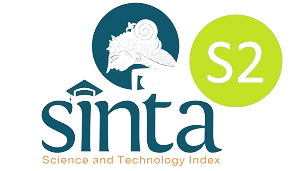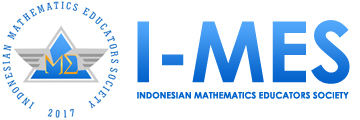Didactical design research on mathematical sequence material in vocational high schools for job preparation
DOI:
https://doi.org/10.29408/jel.v11i2.27753Keywords:
didactical design, learning obstacles, learning trajectories, number sequenceAbstract
The material of sequences and series has many benefits in daily life, so mastery of sequences and series is essential, especially for job selection. This study is based on Didactical Design Research (DDR), which focuses on five twelfth-grade vocational high school students as research subjects. This study uses a methodological framework, which includes three analysis stages: prospective, metapedagogical, and retrospective. The results of this study reveal that: (1) learning obstacles experienced by students are divided into three types, namely ontogenical obstacles, epistemological obstacles, and didactical obstacles; (2) the didactic design developed by the researcher includes hypothetical didactic design 1 (which includes material, examples, and practice questions regarding number arithmetic operations and number patterns), hypothetical didactic design 2 (which includes material, examples, and practice questions regarding arithmetic series and geometric series), and hypothetical didactic design 3 (which contains material, examples, and practice questions regarding types of number series in psychological test questions); (3) Learning obstacles can be overcome by utilizing didactic design; and (4) The empirical didactic design is a synthesis of the material and analysis obtained from hypothetical didactic designs 1, 2, and 3 which have been implemented effectively.
References
Aberdeen, T. (2013). Yin, R. K. (2009). Case study research: design and methods (4th ed.). Thousand oaks, ca: sage. The Canadian Journal of Action Research, 14(1), 69–71. https://doi.org/10.33524/cjar.v14i1.73
Adiastuty, N. (2015). Tahapan pembelajaran matematika smk yang mengarah pada pemecahan masalah (POLYA) [stages of vocational high school mathematics learning that lead to problem solving]. Euclid, 2(2), 331–340. https://doi.org/10.33603/e.v2i2.367
Ardiansari, L., Suryadi, D., & Dasari, D. (2023). Desain didaktis pembelajaran matematika untuk mengatasi learning obstacles siswa smp dalam mempelajari materi aljabar [didactical design of mathematics learning to overcome learning obstacles of junior high school students in learning algebra materials]. JNPM (Jurnal Nasional Pendidikan Matematika), 7(1), 119–128. https://doi.org/10.33603/jnpm.v7i1.7736
Dwijanto, A., D. Tri, S. S., Hartono, U., & Rozaq, K. (2022). Peningkatan kualitas guru smk kabupaten nganjuk melalui pelatihan penulisan karya ilmiah [improving the quality of vocational teachers in nganjuk regency through scientific writing training]. ABIMANYU: Journal of Comunity Engagement, 3(2), 1–15. https://doi.org/10.26740/abi.v3n2.p1-15
Edi, S., Suharno, S., & Widiastuti, I. (2017). Pengembangan standar pelaksanaan praktik kerja industri siswa sekolah menengah kejuruan [development of standards for the implementation of industrial work practices for vocational high school students]. Jurnal Ilmiah Pendidikan Teknik dan Kejuruan, 10(1), 22–30. https://doi.org/10.20961/jiptek.v10i1.14972
Fauzi, I., & Suryadi, D. (2020). The analysis of students’ learning obstacles on the fraction addition material for five graders of elementary schools. Al Ibtida: Jurnal Pendidikan Guru MI, 7(1), 33–45. https://doi.org/10.24235/al.ibtida.snj.v7i1.6020
Fauzia, T. A., Juandi, D., & Purniati, T. (2020). Desain didaktis konsep barisan dan deret aritmetika pada pembelajaran matematika sekolah menengah atas [didactical design of arithmetic rows and sequences concept in high school mathematics learning]. Journal of Mathematics Education Research, 1(1), 1–10. https://doi.org/10.17509/j-mer.v1i2.7743
Frejd, P., & Muhrman, K. (2022). Is the mathematics classroom a suitable learning space for making workplace mathematics visible?–an analysis of a subject integrated team-teaching approach applied in different learning spaces. Journal of Vocational Education and Training, 74(2), 333–351. https://doi.org/10.1080/13636820.2020.1760337
Hampf, F., & Woessmann, L. (2017). Vocational vs general education and employment over the life cycle: new evidence from PIAAC. CESifo Economic Studies, 63(3), 255–269. https://doi.org/10.1093/cesifo/ifx012
Haqq, A. A., Nur’azizah, N., & Toheri, T. (2019). Reduksi hambatan belajar melalui desain didaktis konsep transformasi geometri [reduction of learning barriers through didactical design of geometric transformation concepts]. SJME (Supremum Journal of Mathematics Education), 3(2), 117–127. https://doi.org/10.35706/sjme.v3i2.1901
Hasibuan, E. K. (2018). Analisis kesulitan belajar matematika siswa pada pokok bahasan bangun ruang sisi datar di sekolah menengah pertama [Analysis of students’ mathematics learning difficulties on the subject of flat-sided spaces in junior high school]. AXIOM : Jurnal Pendidikan dan Matematika, 7(1), 18–30. https://doi.org/10.30821/axiom.v7i1.1766
Hitchcock, G. D. H. (1995). Research and the teacher: a qualitative introduction to school-based research. In Sustainability (Switzerland) (Vol. 11, Issue 1). https://doi.org/10.4324/9780203424605
Jatisunda, M. G., Suryadi, D., Prabawanto, S., & Umbara, U. (2024). Pre-service mathematics teacher conducting prospective analysis: a case study on practice didactical design research. Infinity Journal, 14(1), 21–44. https://doi.org/10.22460/infinity.v14i1.p21-44
Jazuli, A., Subekti, F. E., Eka, K. I., & Rahardjo, P. (2022). Pengembangan bahan ajar matematika di sekolah menengah kejuruan dengan pendekatan steam [development of mathematics teaching materials in vocational high school with steam approach]. LPPM - Universitas Muhammadiyah Purwokerto, 4(3), 61–68.
Kaufmann, O. T., & Ryve, A. (2023). Teachers’ framing of students’ difficulties in mathematics learning in collegial discussions. Scandinavian Journal of Educational Research, 67(7), 1069–1085. https://doi.org/10.1080/00313831.2022.2115134
Khairullah, W., & Heriyana, T. (2023). Analisis kesulitan belajar matematika siswa pada materi barisan dan deret kelas sebelas sekolah menengah kejuruan [Analysis of students’ math learning difficulties in eleventh grade row and sequence material at vocational high school]. Indo-MathEdu Intellectuals Journal, 4(2), 427–444. https://doi.org/10.54373/imeij.v4i2.185
Lestari, L. A., & Umbara, U. (2022). Bahan ajar desain didaktis pada pokok bahasan statistika untuk siswa sekolah menengah pertama [didactical design teaching materials on statistics for junior high school students]. SJME (Supremum Journal of Mathematics Education), 6(1), 93–110. https://doi.org/10.35706/sjme.v6i1.5464
Lombard, F., & Weiss, L. (2018). Can didactic transposition and popularization explain transformations of genetic knowledge from research to classroom? Science and Education, 27(5–6), 523–545. https://doi.org/10.1007/s11191-018-9977-8
Mårtensson, S., Lidström, H., & Ekbladh, E. (2023). Students with difficulties managing vocational education in high school: identifying intervention areas related to self-reported student-environment fit and mental health. Journal of Occupational Therapy, Schools, and Early Intervention, 00(00), 1–13. https://doi.org/10.1080/19411243.2023.2215763
Pangestu Putri, D., Manfaat, B., & Haqq, A. A. (2020). Desain didaktis pembelajaran matematika untuk mengatasi hambatan belajar pada materi matriks [didactical design of mathematics learning to overcome learning obstacles on matrix material]. Jurnal Analisa, 6(1), 56–68. https://doi.org/10.15575/ja.v6i1.5694
Refi Elfitra, Y. (2017). Desain situasi didaktis untuk mengantisipasi kecemasan matematika siswa pada pembelajaran konsep aljabar di sekolah [didactical situation design to anticipate student anxiety in learning algebraic concepts in junior high school]. Jurnal Penelitian Pendidikan Matematika, 2(1), 105–120. https://doi.org/10.32502/jp2m.v1i2.1486
Restiana, N. (2019). Materi kompetensi matematika lulusan sekolah menengah kejuruan dan kebutuhan dunia industri [mathematics competency materials for vocational high school graduates and industry needs]. GAUSS: Jurnal Pendidikan Matematika, 2(1), 45–55. https://doi.org/10.30656/gauss.v2i1.1430
Rikayanti. (2018). Buku desain pengembangan bahan ajar metode abstract numerik untuk mendorong budaya literasi knpmp iii 2018 [design book for the development of teaching materials for numerical abstract methods to encourage literacy culture]. 2011, 19–23. https://proceedings.ums.ac.id/knpmp/article/view/1964
Santika, A., Simanjuntak, E. R., Amalia, R., & Kurniasari, S. R. (2023). Peran pendidikan sekolah menengah kejuruan dalam memposisikan lulusan siswanya mencari pekerjaan [the role of vocational high school education in positioning graduating students for employment]. Jurnal Kajian, Penelitian Dan Pengembangan Kependidikan, 14(1), 84–94. https://doi.org/10.31764/paedagoria.v14i1.12626
Sawitri, Z. A., Fuadiah, N. F., & Tanzimah, T. (2020). Analisis learning obstacles pada materi volume limas [analysis of learning obstacles in pyramid volume material]. Indiktika : Jurnal Inovasi Pendidikan Matematika, 3(1), 16–25. https://doi.org/10.31851/indiktika.v3i1.4930
Scriven, M. (1990). Can research-based teacher evaluation be saved? Journal of Personnel Evaluation in Education, 4(1), 19–32. https://doi.org/10.1007/BF00177127
Senjayawati, E., & Kadarisma, G. (2020). Pengembangan bahan ajar desain didaktis [development of didactical design materials to improve]. Jurnal Matematika dan Pendidikan Matematika, 5(2), 20–33. https://doi.org/10.26594/jmpm.v5i2.2082
Soleh, A. A., Triyanto, T., Parno, P., Suharno, S., & Estriyanto, Y. (2023). Tinjauan pustaka sistematis: model kemitraan antara sekolah menengah kejuruan dengan dunia usaha dan dunia industri [systematic literature review: a model of partnership between vocational high schools and businesses and industries]. Jiptek, 16(2), 126–136. https://doi.org/10.20961/jiptek.v16i2.72697
Sumaji, S., & Wahyudi, W. (2020). Refleksi pembelajaran matematika sekolah menengah kejuruan pada materi persamaan dan pertidaksamaan linear mutlak [reflection on mathematics learning at vocational high school on the matter of absolute linear]. Jurnal Cendekia : Jurnal Pendidikan Matematika, 4(2), 746–755. https://doi.org/10.31004/cendekia.v4i2.281
Suryadi Didi. (2018). Prosiding seminar nasional matematik dan pendidikan matematika [proceedings of the national seminar on mathematics and mathematics education]. In Laboratorium Penelitian dan Pengembangan FARMAKA TROPIS Fakultas Farmasi Universitas Mualawarman, Samarinda, Kalimantan Timur (Vol. 27, Issue 3).
Tsamir, P., Tirosh, D., Levenson, E., Barkai, R., & Tabach, M. (2015). Early years teachers’ concept images and concept definitions: triangles, circles, and cylinders. ZDM Mathematics Education, 47(3), 497–509. https://doi.org/10.1007/s11858-014-0641-8
Yaakob, M. F. M., Don, Y., Sufi, I., & Yusof, M. R. (2020). Teachers’ professional development level across cohort of generations in malaysia. International Journal of Instruction, 13(4), 443–456. https://doi.org/10.29333/iji.2020.13428a
Downloads
Published
How to Cite
Issue
Section
License
Copyright (c) 2025 Tio Heriyana Tio, Uba Umbara, Evan Farhan Wahyu Puadi

This work is licensed under a Creative Commons Attribution-ShareAlike 4.0 International License.
Authors who publish with the Jurnal Elemen agree to the following terms:
- Authors retain copyright and grant the journal right of first publication with the work simultaneously licensed under Creative Commons Attribution-ShareAlike 4.0 International License (CC BY-SA 4.0).
- Authors are able to enter into separate, additional contractual arrangements for the distribution of the journal's published version of the work (e.g., post it to an institutional repository or publish it in a book), with an acknowledgment of its initial publication in this journal.
- Authors are permitted and encouraged to post their work online (e.g., in institutional repositories or on their website) prior to and during the submission process, as it can lead to productive exchanges, as well as earlier and greater citation of published work.
Jurnal Elemen is licensed under a Creative Commons Attribution-ShareAlike 4.0 International License





